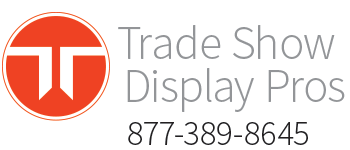by Bryan Kilpatrick
Trade shows, for most industries, are expected to make a comeback in 2021. And, they should; face-to-face connections are important in any context, but especially so when most of the world hasn’t had a chance to do so for the majority of a calendar year. But as we push forward, we must do so in a safe manner.
Fortunately, trade show organizers are laying out plans for reconfigurations to allow for adequate social distancing in addition to other safety implementations such as temperature checks, separate entrances and exits, face mask requirements, and more. Plus, there’s a growing number of display products available that can help presenters effectively communicate their brand or message while also contributing to the safety of show attendees. These products, while maybe not required, will be strongly encouraged, not to mention a vital part of any success organizers will have with hosting shows in the midst—or, optimistically, at the tail end—of a pandemic. For exhibitors, proving to attendees who can potentially end up as clients, customers, or business partners that they're able to balance the need for in-person interaction with taking necessary safety precautions will be important and, hopefully, rewarding.
So, what are those safety precautions, exactly? And, how will they look once trade shows really start kicking into gear again? A pair of safe and successful U.S. events that flew under the radar during the summer of 2020 could reveal the answers to those questions.
- Reduced capacity
- Makeshift individual rooms within convention areas
On the surface, it would seem like a larger open space would be best when trying to accommodate social distancing guidelines. However, individual rooms work for limiting gatherings and help with keeping track of who was in which space during specific periods of time. Banner walls—particularly, those that come in kits with attachments that allow them to be configured into rooms of various sizes—are a great solution for creating separate spaces on the fly.
- Staggered arrival times
- Wider aisles with medians and signage
Directing the flow of traffic is a relatively simple way to encourage social distancing, especially when considering people are already conditioned to it in grocery stores, on actual roads, etc. Guardrails equipped with banners featuring instructions, advertisements, or other information make for a nice separator. Strategically placed floor decals can help ensure attendees are keeping their distance and headed in the right direction.
- Recorded public address announcements reminding exhibitors and attendees of protocols on a timed loop
- Plenty of signage displaying safety warnings, reminders, and requirements
Window decals and other signs conveying mask requirements, distancing and sanitizing reminders, and other pertinent information should be seen by people long before the enter the facility. That signage can come in many forms, from simple wall decals to sturdy A-frame units, or even stands equipped with a sign and hand sanitizer dispenser.
- Temperature checks for event staff and exhibitors
- New sanitation measures
In addition to event staff more frequently cleaning surfaces, exhibitors themselves will need to take action to ensure the cleanliness of their individual booths. Hand sanitizing stations that double as eye-catching banner stands complete with brand messaging and other information are a great inclusion. Anti-microbial table covers and films that can be applied to virtually any rigid surface can help curtail the spread of viruses. And protective shields aren’t a bad idea, either, particularly in—but not limited to—situations during which the physical exchange of information is necessary.
- Elimination of on-site concessions
- iPads for check-in and traffic tracking
Event staff can be placed and each entrance and exit to record the information in real time, or the use of iPad stands as check-in and check-out stations could be implemented, with staffers monitoring the data and acting accordingly in an effort to manage traffic.
With all of this information in mind, it’s time to start thinking about how to prepare for a different, but still entirely functional and beneficial, trade show landscape. By planning ahead, you can take advantage of all of the special discounts being offered and avoid the inevitable price hikes—and added stress—brought on by the last-minute craze that will undoubtedly occur as these shows draw nearer.
For more information on these and other trade show products, contact a Power Graphics representative today.
